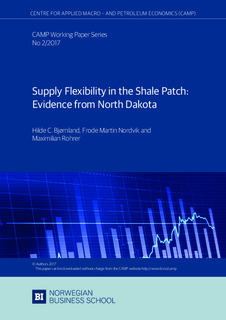| dc.contributor.author | Bjørnland, Hilde C. | |
| dc.contributor.author | Nordvik, Frode Martin | |
| dc.contributor.author | Rohrer, Maximilian | |
| dc.date.accessioned | 2017-03-15T13:48:52Z | |
| dc.date.available | 2017-03-15T13:48:52Z | |
| dc.date.issued | 2017 | |
| dc.identifier.issn | 1892-2198 | |
| dc.identifier.uri | http://hdl.handle.net/11250/2434235 | |
| dc.description.abstract | We analyse if output exibility in oil production depends on the extraction technology. In particular, we ask to what extent shale oil producers respond to price incentives by changing completion of new wells as well as oil production from completed wells. Using a novel well-level monthly production data setcovering more than 15,000 crude oil wells in North Dakota, we nd large di erences in response between conventional and unconventional (shale) extraction technology: While shale oil wells respond signi cantly to spot future spreads by changing both well completion and crude oil production, conventional wells do not. Our results indicate that fi rms using shale oil technology are more flexible in allocating output intertemporally. We interpret such output pattern of shale oil wells to be consistent with the Hotelling therory of optimal extraction. | nb_NO |
| dc.language.iso | eng | nb_NO |
| dc.publisher | BI Norwegian Business School | nb_NO |
| dc.relation.ispartofseries | CAMP Working Paper Series;2/2017 | |
| dc.subject | Oil extraction | nb_NO |
| dc.subject | US oil shale boom | nb_NO |
| dc.subject | Hotelling theory | nb_NO |
| dc.subject | Crude oil prices | nb_NO |
| dc.title | Supply Flexibility in the Shale Patch: Evidence from North Dakota | nb_NO |
| dc.type | Working paper | nb_NO |
| dc.source.pagenumber | 37 | nb_NO |
